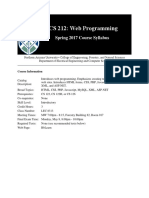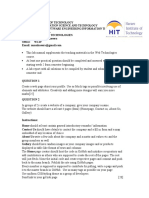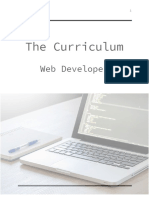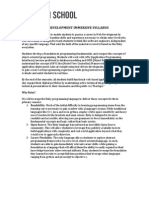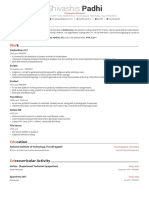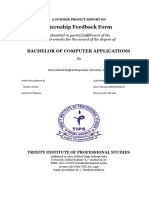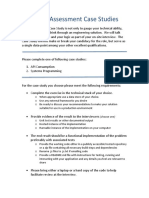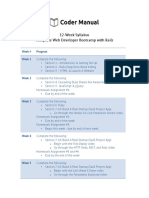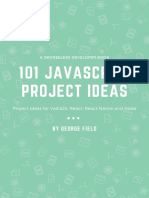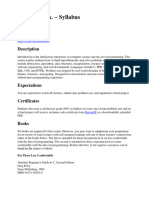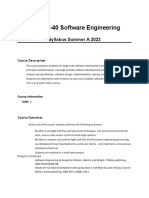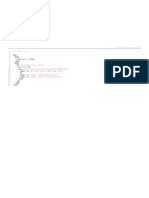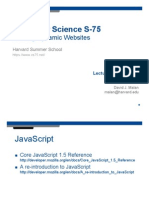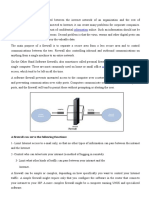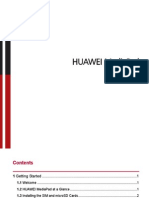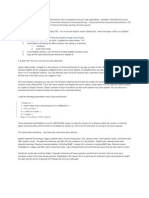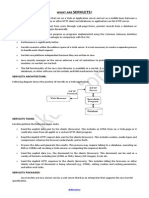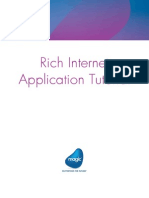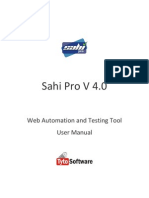Computer
Science
S-75:
Building
Dynamic
Websites
Harvard
Summer
School
Summer
2012
Project
2:
The
BART
due
Wed
8/1,
noon
ET
Goals.
Introduce
you
to
Ajax.
Introduce
you
to
third-party
APIs.
Recommended
Reading.
http://www.w3schools.com/dom/
http://www.w3schools.com/js/
http://www.w3schools.com/ajax/
http://www.bart.gov/schedules/developers/etas.aspx
http://api.bart.gov/docs/overview/
http://code.google.com/apis/maps/documentation/javascript/
0
<
4
�Computer
Science
S-75:
Building
Dynamic
Websites
Harvard
Summer
School
Summer
2012
Academic
Honesty
All
work
that
you
do
toward
fulfillment
of
this
courses
expectations
must
be
your
own
unless
collaboration
is
explicitly
allowed
(e.g.,
by
some
problem
set
or
the
final
project).
Viewing
or
copying
another
individuals
work
(even
if
left
by
a
printer,
stored
in
an
executable
directory,
or
accidentally
shared
in
the
courses
virtual
classroom)
or
lifting
material
from
a
book,
magazine,
website,
or
other
sourceeven
in
partand
presenting
it
as
your
own
constitutes
academic
dishonesty,
as
does
showing
or
giving
your
work,
even
in
part,
to
another
student.
Similarly
is
dual
submission
academic
dishonesty:
you
may
not
submit
the
same
or
similar
work
to
this
course
that
you
have
submitted
or
will
submit
to
another.
Nor
may
you
provide
or
make
available
your
or
other
students
solutions
to
Project
0,
Project
1,
or
Project
2
to
individuals
who
take
or
may
take
this
course
(or
CSCI
E-75)
in
the
future.
You
are
welcome
to
discuss
the
courses
material
with
others
in
order
to
better
understand
it.
You
may
even
discuss
problem
sets
with
classmates,
but
you
may
not
share
code.
You
may
also
turn
to
the
Web
for
instruction
beyond
the
courses
lectures
and
sections,
for
references,
and
for
solutions
to
technical
difficulties,
but
not
for
outright
solutions
to
problems
on
projects.
However,
failure
to
cite
(as
with
comments)
the
origin
of
any
code
or
technique
that
you
do
discover
outside
of
the
courses
lectures
and
sections
(even
while
respecting
these
constraints)
and
then
integrate
into
your
own
work
may
be
considered
academic
dishonesty.
If
in
doubt
as
to
the
appropriateness
of
some
discussion
or
action,
contact
the
staff.
All
forms
of
academic
dishonesty
are
dealt
with
harshly.
If
the
course
refers
some
matter
to
the
Administrative
Board
and
the
outcome
for
some
student
is
disciplinary
action,
the
course
reserves
the
right
to
impose
local
sanctions
on
top
of
that
outcome
for
that
student
that
may
include,
but
not
be
limited
to,
a
failing
grade
for
work
submitted
or
for
the
course
itself.
Grades.
Your
code
(CSS,
HTML,
JavaScript,
PHP,
etc.)
will
be
evaluated
along
the
following
axes.
Scope.
To
what
extent
does
your
code
implement
the
features
required
by
our
specification?
Correctness.
To
what
extent
is
your
code
consistent
with
our
specifications
and
free
of
bugs?
Design.
To
what
extent
is
your
code
written
well
(i.e.,
clearly,
efficiently,
elegantly,
and/or
logically)?
Style.
To
what
extent
is
your
code
readable
(i.e.,
commented
and
indented
with
variables
aptly
named)?
1
<
4
�Computer
Science
S-75:
Building
Dynamic
Websites
Harvard
Summer
School
Summer
2012
BitBucket.
So
that
you
have
a
place
to
store
revisions
of
this
project
privately,
head
to
https://bitbucket.org/
and
create
a
project2
repo!
Implementation.
Your
mission
for
this
project
is
to
implement
The
Bart,
a
mashup
that
allows
users
to
visualize
BART
routes
on
a
Google
Map
and
also
click
stations
to
see
when
the
next
trains
depart
(or
arrive).
The
overall
design
and
aesthetics
of
this
site
are
ultimately
up
to
you,
but
we
require
that
your
site
meet
some
requirements.
All
other
details
are
left
to
your
own
creativity
and
interpretation.
Feature
Requirements.
Your
sites
homepage
must
display
an
embedded
Google
Map,
centered
and
zoomed
in
on
San
Francisco.
Your
sites
homepage
must
provide
the
user
with
a
way
of
selecting
one
BART
route
at
a
time.
Once
selected,
a
route
should
be
drawn
as
polylines
on
the
map
in
the
routes
official
color,
with
markers
representing
each
of
that
routes
stations.
Each
station,
when
clicked,
should
trigger
an
info
window
that
summarizes
the
next
trains
departing
from
(or
arriving
at)
that
station.
Technical
Requirements.
Youre
welcome
to
develop
your
site
on
any
computer
using
any
IDE
or
text
editor,
even
without
using
the
CS50
Appliance,
but
you
must
ultimately
ensure
that
it
works
within
the
CS50
Appliance
at
a
URL
of
http://project2/
when
installed
in
/home/jharvard/vhosts/project2/.
Only
files
that
should
be
web-accessible
should
live
in
project2/html/;
everything
else
should
live
in
project2/
or
some
(other)
subdirectory
therein.
Your
site
must
use
version
3
of
the
Google
Maps
JavaScript
API.
It
suffices
to
use
only
the
Real
BART
API
(http://api.bart.gov/docs/overview/),
but
you
are
welcome
to
use
the
Simple
ETA
Feed
(http://www.bart.gov/schedules/developers/etas.aspx)
and/or
the
GTFS
feed
(http://www.bart.gov/dev/schedules/google_transit.zip).
You
should
cache
locally
(on
disk
or
in
a
MySQL
database)
data
that
does
not
change
every
minute
(e.g.,
routes
and
their
stations).
Your
mashup
should
only
query
the
BART
API
or
(Simple
ETA
Feed)
for
real-time
departure
(or
arrival)
times.
Your
markup
language
should
be
valid
(or
tentatively
valid)
HTML5,
as
per
http://validator.w3.org/,
unless
some
feature
of
your
site
requires
otherwise
(for
the
sake
of
some
browser);
explain
in
HTML
comments
any
intentional
invalidities.
Your
HTML
should
also
be
as
pretty-printed
as
possible.
Your
CSS
need
not
be
valid.
Any
JavaScript
or
PHP
code
that
you
write
must
be
extensively
commented
and
be
as
pretty-printed
as
possible.
2
<
4
�Computer
Science
S-75:
Building
Dynamic
Websites
Harvard
Summer
School
Summer
2012
You
may
use
a
WYSIWYG
editor
to
generate
HTML
and/or
CSS
that
you
would
like
to
use
in
your
site.
If
you
integrate
third-party
CSS
or
JavaScript
libraries
into
your
project,
cite
their
origin
with
comments.
If
you
incorporate
or
adapt
snippets
of
code
from
the
Web
into
your
project
(e.g.,
examples
from
php.net),
cite
the
codes
origins
with
PHP
comments.
If
you
incorporate
images
from
the
Web
into
your
project,
cite
the
images
with
HTML
comments.
Your
website
must
appear
and
behave
the
same
on
the
latest
versions
of
at
least
two
of
these
browsers:
Chrome
Firefox
Internet
Explorer
Opera
Safari
Exit
Interview.
Once
done
with
your
site,
put
together
a
readme
in
a
file
called
README
that
lives
in
the
same
folder
as
the
rest
of
your
project.
Treat
this
readme
as
your
opportunity
not
only
to
explain
but
to
justify
your
design
decisions.
Tell
us
why
you
designed
your
project
as
you
did.
Tell
us
with
which
two
(or
more)
browsers
we
should
evaluate
your
site.
And
give
us
an
overall
sense
of
how
your
site
works
(e.g.,
tell
us
which
files
do
what).
But
still
be
succinct;
keep
this
readme
to
just
a
few
paragraphs
in
length.
How
to
Submit.
A
few
days
prior
to
this
projects
deadline,
instructions
for
submitting
your
work
will
be
announced
at
https://www.cs75.net/.
Be
sure
to
look
for
those
directions
and
then
submit
your
work
prior
to
this
projects
deadline.
3
<
4




